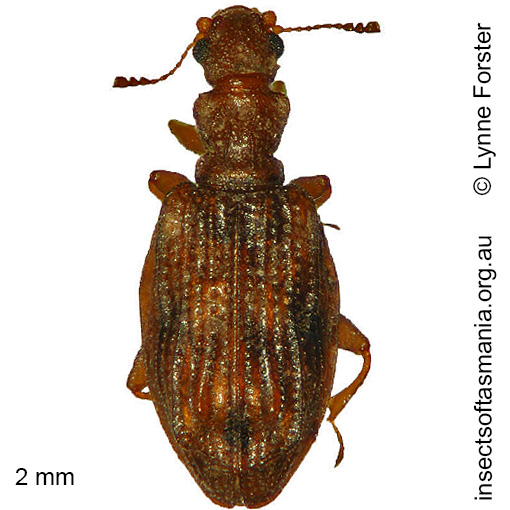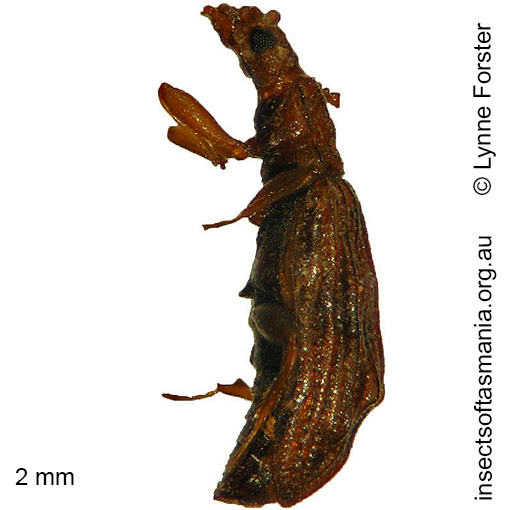
Cartodere nodifer (a species of minute brown scavenger-beetle)
Basis for Tasmanian occurrence
TMAG collections
Classification
Order: Coleoptera
Suborder: Polyphaga
Superfamily: Coccinelloidea
Family: Latridiidae
Subfamily: Latridiinae
Morphology
Flightedness: winged and assumed capable of flight
Morphology (characterised by L. Forster): — Abdomen ventrally with pointy projections near hind coxae — Antennae with three-segmented club; scape large and globular — Elytra with carinae on striae — Femora thickened (in males) — Head with median groove on frons, and with temples at least as long as eyes — Pronotum narrower than elytra, constricted near base, with two carinae; waxy exudate on sides — Ventrites with ventrite 1 long.
Source literature on morphology and taxonomy (*primary taxonomic source, where identified):
Lawrence, J.F. & Britton, E.B. (1994). Australian Beetles. Melbourne: CSIRO. Melbourne University Press.
Ecology
Association with dead wood or old trees: at least facultatively saproxylic
Ecological attributes: — Affiliated with late-aged (ex-clearfelled) forest (Michaels, 1999) — Affiliated with late-aged (ex-clearfelled) forest (Michaels, 1999) — Affiliated with lowland (<500 m altitude) wet forest (Forster & Grove, 2009) — Affiliated with older trees (Harrison, 2007) — May occupy logs or trunks of Eucalyptus obliqua, at least temporarily, since found having emerged within a year of felling (Grove & Bashford, 2003) — May occupy logs or trunks of Eucalyptus obliqua, at least temporarily, since found having emerged within six years of felling (Grove et al., 2009).
Collection method(s) for TMAG material: — Baited trapping (funnel trap) — Beating foliage of Dicksonia antarctica (Jones, 2007) — Emergence trapping from cut billets of Eucalyptus obliqua (Harrison, 2007) — Emergence trapping from log of Eucalyptus obliqua — Flight intercept trapping (trough below Malaise trap) — Knockdown fogging of canopy of Acacia melanoxylon — Knockdown fogging of canopy of Athrotaxis selaginoides — Knockdown fogging of canopy of Eucalyptus obliqua — Knockdown fogging of canopy of Nothofagus cunninghamii — Malaise trapping — Pitfall trapping — Trunk window trapping (Harrison, 2007) — Vane trapping.
Source ecological literature:
Grove, S.J. & Bashford, R. (2003). Beetle assemblages from the Warra log decay project: insights from the first year of sampling. Tasforests 14: 117-129.
Grove, S.J. (2009b). Beetles and fuelwood harvesting: a retrospective study from Tasmania’s southern forests. Tasforests 18: 77-99.
Hopkins, A.J.M. et al. (2005). Wood decay fungi and beetle assemblages associated with living Eucalyptus obliqua trees: early results from studies at the Warra LTER Site, Ta
Baker, S.C. (2000). Forest litter beetles and their habitat: a comparison of forest regenerated by wildfire and logging practices. Hons. thesis, Univ. of Tasmania, Hobart.
Baker, S.C. (2006b). Ecology and conservation of ground-dwelling beetles in managed wet eucalypt forest: edge and riparian effects. PhD thesis, Univ. of Tasmania, Hobart.
Grove, S. et al. (2009). A long-term experimental study of saproxylic beetle … succession in Tasmanian Eucalyptus … logs… In: Fattorini, S. (Ed.), Insect Ecology and Conservation. Research Signpost, pp. 71-114.
Harrison, K.S. (2007). Saproxylic beetles associated with habitat features in Eucalyptus obliqua trees in the southern forests of Tasmania. PhD thesis, Dept. of Zoology, Univ. of Tasmania, Hobart.
Michaels, K.F. (1999a). Carabid beetles as biodiversity and ecological indicators. PhD thesis, Univ. of Tasmania, Hobart.
Yee, M. (2005). The ecology and habitat requirements of saproxylic beetles native to Tasmanian wet eucalypt forests: potential impacts of commercial forestry practices. PhD thesis, Univ. of Tasmania, Hobart.


